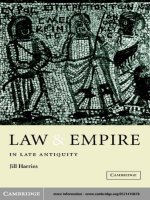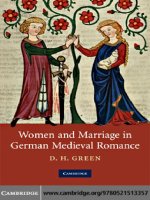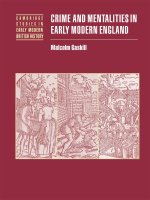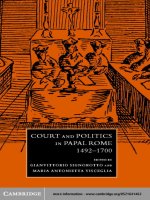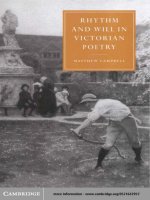0521850355 cambridge university press law and representation in early modern drama nov 2006
Bạn đang xem bản rút gọn của tài liệu. Xem và tải ngay bản đầy đủ của tài liệu tại đây (2.67 MB, 315 trang )
This page intentionally left blank
LAW AND REPRESENTATION IN EARLY
MODERN DRAMA
This examination of the relation between law and drama in Renaissance England establishes the diversity of their dialogue, encompassing critique and complicity, comment and analogy, but argues that
the way in which drama addresses legal problems and dilemmas is
nevertheless distinctive. As the resemblance between law and theatre
concerns their formal structures rather than their methods and aims,
an interdisciplinary approach must be alive to distinctions as well as
affinities. Alert to issues of representation without losing sight of a
lived culture of litigation, this study primarily focuses on early
modern implications of the connection between legal and dramatic
evidence, but expands to address a wider range of issues which
stretch the representational capacities of both courtroom and
theatre. The book does not shy away from drama’s composite vision
of legal realities but engages with the fictionality itself as significant,
and negotiates the methodological challenges it posits.
is Lecturer in English at the University of
Cambridge, and Fellow and Director of Studies in English at
Fitzwilliam College. She has contributed to Shakespeare Survey 49
(Cambridge, 1996), Shakespeare and Sexuality, edited by Catherine
Alexander and Stanley Wells (Cambridge, 2001) and Literature,
Politics and the Law in Renaissance England, edited by Erica Sheen
and Lorna Hutson (2004). Her work has also appeared in the
journals English Literary Renaissance and Essays in Criticism.
S ubh a M u k he r ji
LAW AND REPRESENTATION
IN EARLY MODERN DRAMA
SUBHA MUKHERJI
CAMBRIDGE UNIVERSITY PRESS
Cambridge, New York, Melbourne, Madrid, Cape Town, Singapore, São Paulo
Cambridge University Press
The Edinburgh Building, Cambridge CB2 8RU, UK
Published in the United States of America by Cambridge University Press, New York
www.cambridge.org
Information on this title: www.cambridge.org/9780521850353
© Subha Mukherji 2006
This publication is in copyright. Subject to statutory exception and to the provision of
relevant collective licensing agreements, no reproduction of any part may take place
without the written permission of Cambridge University Press.
First published in print format 2006
eBook (EBL)
ISBN-13 978-0-511-34910-2
ISBN-10 0-511-34910-6
eBook (EBL)
ISBN-13
ISBN-10
hardback
978-0-521-85035-3
hardback
0-521-85035-5
Cambridge University Press has no responsibility for the persistence or accuracy of urls
for external or third-party internet websites referred to in this publication, and does not
guarantee that any content on such websites is, or will remain, accurate or appropriate.
173973
In memory of ‘Dada’
Tarapada Mukherji (1902–1987)
Contents
395392
List of illustrations
List of maps
Acknowledgements
Glossary
A note on the text
List of abbreviations
page ix
x
xi
xiii
xviii
xix
Introduction
1
1 ‘Of rings, and things, and fine array’: marriage law,
evidence and uncertainty
17
2 ‘Unmanly indignities’: adultery, evidence and
judgement in Heywood’s A Woman Killed
With Kindness
55
3 Evidence and representation on ‘the theatre
of God’s judgements’: A Warning for Fair Women
95
4 ‘Painted devils’: image-making and evidence in
The White Devil
135
5 Locations of law: spaces, people, play
174
6
‘When women go to Law, the Devil is full of
Business’: women, law and dramatic realism
vii
206
viii
Contents
Epilogue: The Hydra head, the labyrinth and the waxen nose:
discursive metaphors for law
233
Appendix
Bibliography
Index
249
258
287
353217
2.1
2.2
2.3
5.1
Illustrations
Love letter sent by John Covile, Fellow of Queens’, to
Bridget Edmunds, wife of John Edmunds, M. A.,
Peterhouse, and employee of the university. Cambridge
University Library, Vice-Chancellor’s Court III.5, item 66.
Reproduced by permission of the Syndics of the
University Library of Cambridge.
Letter from John Covile to Bridget Edmunds.
Cambridge University Library, Vice-Chancellor’s
Court III.5, item 67a. Reproduced by permission of the
Syndics of the University Library of Cambridge.
Letter from John Covile to Bridget Edmunds.
Cambridge University Library, Vice-Chancellor’s
Court III.5, item 68. Reproduced by permission of the
Syndics of the University Library of Cambridge.
‘The Courts of King’s Bench and Chancery in
Westminster Hall’, mid-seventeenth century; by
anonymous draughtsman, possibly Dutch; British
Museum, reproduced in Legal London: an Exhibition
in the great Hall of the royal Courts of Justice (London,
1971), no. 9. Reproduced by permission of the
British Museum.
ix
page 58
59
60
196
353217
Maps
1 A map of theatrical and legal London, showing the
geographical overlap between the Inns and the theatres,
especially their proximity to the private theatres.
Based on the ‘Key Map’ in The A to Z of Elizabethan
London, compiled by Adrian Prockter and Robert Taylor,
London Topographical Society Publication no. 122
(London, 1979), p. 1.
2 Map locating Ram Alley and Mitre Tavern in relation to
legal London. Based on Map 19 in The A to Z of
Elizabethan London, compiled by Adrian Prockter and
Robert Taylor, London Topographical Society
Publication no. 122 (London, 1979), p. 20.
3 Close-up of the neighbourhood south of Fleet Street which
housed the Mitre Tavern (k34), the lane leading out of its
back-door and to Ram Alley (k40).
x
page 176
177
180
353217
Acknowledgements
My most profound debt is to Anne Barton. She sustained her faith in me,
and in the thesis that forms the basis of this book, quite literally in
sickness and in health, and through great gaps of time. Without her
support, both academic and personal, this piece of work might have
languished.
Two others to whom I owe much are John Kerrigan and Tony Nuttall.
John supervised the M.Phil dissertation from which this research developed, and has continued to offer a degree of support that goes beyond
the call of his duty or my claim. He has sustained me with practical advice
and general encouragement, read early drafts of chapters and provided
incisive criticism. I feel the deepest gratitude for all this. My debt to Tony
is for his intellectual bounty, for ‘there was no winter in’t’. I have learnt
more from him than I have been able to use in the book, and my thanks to
him are for immeasurably more than this specific venture.
I am grateful to John Baker for entertaining ignorant questions about
legal procedure with humour and largesse; and to Neil Jones for clarification on specific legal terms. My thanks to Jim Sharpe for a clarifying
conversation about law courts at an early stage of this work; to Marie
Axton and the late Jeremy Maule for their active encouragement of my
archival research; and to Ian Donaldson and Emrys Jones for their help as
examiners of my Ph.D. thesis. Many thanks to Marina Kiprianou and Jen
Pollard for their help with maps.
Lorna Hutson and Luke Wilson provided invaluable constructive
criticism and advice for revision. So did Colin Burrow at an earlier stage.
Thanks to Terence Cave and Jan Schramm for illuminating conversations
at crucial junctures, and to Peter Goodrich for inspiration and encouragement. Sarah Stanton has been an admirably patient and supportive editor.
The manifold inadequacies that remain, I acknowledge mine.
Many friends, in their different ways, have supported me, and my
research, over the years. My thanks go to Moitrayee Basu, Yota Batsaki,
xi
xii
Acknowledgements
Pippa Berry, Supriya and Sukanta Chaudhuri, Nadina Christopoulou,
Eleanor Coghill, Santanu Das, Tania Demetriou, Dan Dombey, Pietro
del Favero, Christine Garabedian, Bahi Ghubril, Nick Hammond, Juan
Jose´ Herrera de la Muela, Andreas Janousch, Gabriel Josipovici, Aptin
Khanbaghi, Mary Laven, Supriyo Mitra, Katy Mullin, Ralph and Cle`mence O’Connor, Debdulal Roy, Ray Ryan, Jason Scott-Warren and Hugh
Stevens. Katy, Tania, Yota, Ralph, Santanu, Supriya and Jason read parts
of the text with care, and offered suggestions for editing and refining.
Dan’s characteristic and constructive ruthlessness has no doubt made the
Introduction a little more readable than it might have been. Thanks to
Mike Hallsworth for his help with the Bibliography. Special thanks
to Yota and Tania for making the much-interrupted period of revision
bearable, even fun. Two unique debts demand mention: to Katy, for
endless sloe gins and stimulating distraction which it is now her turn to
acknowledge; and to Santanu, for unfailing comic relief.
I owe gratitude to the Fellows of Fitzwilliam College, Cambridge, for
providing a stimulating environment for work. In particular, I would like
to acknowledge the kindness and support of Nicky Padfield, John
Cleaver, Amy Goymour, Brian Johnson and John Leigh. Thanks also to
my students past and present, who made my arrival in Fitzwilliam joyful,
have kept me mentally agile, and provided remarkable support and
affection through the years.
Last, but by no means least, I am grateful to my parents, Indrani and
Asoke Mukherji, for their unconditional love, their long-distance support
and their patience.
My most far-reaching debt – at once personal and intellectual – is to
my late grandfather, as acknowledged in the dedication.
Glossary
Common law
Canon law
The body of laws that emerged in England in the
middle ages, developed from arguments and rulings
used in actual cases and based on the practice of ‘the
law of the land’ rather than written and codified in
textual form; taught at the Inns of Courts (professional
law schools – and more) until the middle of the
seventeenth century, and then left largely to self-help;
administered mainly through the central courts of
common law, but also through assizes in the
counties. So the term also referred to a professional
structure, independent of the university law faculties.
The law of the Church of Rome, initially systematised
in Gratian’s Decretum (c.1140), expanded by the
fourteenth century into the Corpus Juris Canonici. It
continued to be in force in England, even after the
Reformation, in ecclesiastical jurisdictions, and was
administered through church courts. From 1857 the
jurisdiction of church courts was confined to Church
matters, but in the sixteenth and seventeenth centuries
it was expansive, and covered marriage, bastardy,
personal property, sexual morality and spiritual
matters, defamation, wills and probate, and church
governance. Canon law was taught in the English
universities until 1535, the year which marked the
formal closure of the separate canon law faculties
(and degrees) at Oxbridge. But some study of it
seems to have informally survived at the universities
under the wider auspices of Civil law. It was in any
case heavily influenced by Roman law method and to
some extent by Roman law content.
xiii
xiv
Civil law
Dower and
jointure
Depositions
Elenchus
Fact
Glossary
Roman Civil law, codified in the Corpus Juris Civilis
established by Emperor Justinian in the sixth century.
In the Renaissance, this text-based system was still
authoritative on the Continent, but England had
evolved its own ‘common law’, which was unwritten.
Students of jurisprudence at Oxford and Cambridge
studied the literature of Civil law, while law students at
the Inns of Courts studied the practice of common
law. Doctors of Civil law from the universities went on
to become practitioners or judges at the English
ecclesiastical and admiralty courts till 1857. Civil
law could also be occasionally relevant to Council
arbitration, and to prerogative and equity court
action; but the bulk of secular legal action in England
was under common law which rendered Civil law
largely academic. Note that in some contexts, the
term ‘civil law’ could also be used, in an entirely
separate sense, to describe civil as opposed to criminal
action: a law that dealt with disputes between private
individuals and organisations.
Dower was a widow’s entitlement, for her lifetime, to a
third of the real property held by her husband during
the marriage. But the law was asymmetrical, for a
widower was entitled to all of his wife’s real property
for the rest of his life, provided a child had been born,
not simply a third. A jointure, on the other hand, was
joint tenancy of land, usually agreed upon in the
marriage settlement, from which a widow could
receive income for her life.
The responses of witnesses and deponents to official
court interrogatories; usually written down by clerks of
court before a trial and thereafter presented during the
trial.
A maxim or precept, in rhetoric, that contradicts a
given ‘colour’ and offers the opposite case. Plural:
elenches.
Alleged deed, usually assumed to be of a criminal
nature; but a conjectural entity rather than an
established or objective truth.
Glossary
Feoffment
Inns of
Chancery
xv
A grant in fee simple, made by ‘feoffor’ (or ‘feoffer’ or
‘feeoffer’) to a ‘feoffee’. This could be an ‘ordinary
feoffment’, i.e. a feoffment not involving uses but
made upon sale or gift where the feoffor retained the
whole interest; in such a case, the trustee would be the
legal owner of the property only on the understanding
that he would hold it not for his own benefit but for
the benefit of beneficiaries. The other kind of
feoffment was a feoffment to uses – a product of the
arrangement whereby a feudal tenant was bound, by
contract or trust, to allow another person – the
landowner, or, often, his heirs – to have the
beneficial enjoyment of land vested in himself. Yet
law could only grant one right – that of the tenant –
so there was a conflict between legal right and actual
ownership. This practice of granting ‘use’ of land
inevitably led to discontents and misuse. So it had to
be a matter of mere trust, since the only person
entitled to enter on breach after the feoffor’s death
was the heir. If the feoffee failed to perform the
conditions specified by the feoffor, the land reverted
back automatically to the feoffer or his heirs. But it
also allowed a feoffor to defer selection of successors to
the land until he approached death, since the land
would be meanwhile invested in others, while he
himself still enjoyed absolute ownership and profits
ensuing from the land. Or he could sell it off before
such time by simply commanding his feoffees to
convey it to his purchaser. Note that by the sixteenth
century, feudal land law, originally the province of
local civil law and manorial custom, had effectively
passed into the jurisdiction of royal justice, and
tenancy had become a function of English common
law.
Lesser Inns – hospicia minora – which, by 1600, were
attached to particular Inns of Court. They gave
instruction, provided by barristers sent from the Inns
of Court as ‘readers’, and moots were held there.
Ideally, one was supposed to spend a couple of years
in one before proceeding to an Inn of Court – witness
xvi
Glossary
Justice Shallow in Shakespeare’s 2Henry IV, who was
at Clement’s Inn. Their ruling members were not
barristers, but attorneys who had not joined the Inns
of Court. A member of an Inn of Chancery could be
considered a lawyer if he practised law as an attorney
(as many of them did). But most members of the Inns
of Chancery, and indeed of the Inns of Court, never
studied or practised law, so membership by itself does
not indicate a lawyer.
Inns of Court
Professional law-schools of England, established in the
fourteenth century, situated in London: Gray’s Inn,
Lincoln’s Inn, Middle Temple and Inner Temple.
English common law was not taught at the
universities but at the Inns – the reason why they
were informally termed the ‘Third University of
England’. They were also a residential society of
lawyers, with their own customs and entertainments,
and indeed often used as a finishing school for young
men not necessarily intending to join the legal
profession.
Interrogatories A set of questions prepared by the court and put to the
witnesses and defendants in a case.
Inventio or
Rhetorical term meaning the finding or amassing of
Invention
matter, or the matter or idea itself; it was the first ‘part’
of rhetoric, which was then to be arranged, memorised
and delivered to the greatest effect. As the anonymous
writer of Ad Herennium says of classical rhetoric:
‘among the five tasks of the orator, the mastery of
invention is both the most important and most
difficult of all’ (Ad C. Herennium 1954, II. I.I, 58).
Paraphernalia
A wife’s linen, jewellery and plate, and in some cases
her bed – property originally part of her husband’s
estate which she could claim as a widow.
Pin-money
Early modern equivalent of pocket-money for trinkets
so that a woman did not constantly have to pester her
husband; held by a married woman as a personal
annual income.
Plus quam satis ‘More than enough’; a phrase typically applied to
charges of incontinency in adultery cases, and
possibly linked to impotence in annulment cases.
Glossary
Seisin
Separate estate
xvii
The situation of being in possession in one’s capacity
of a feudal tenant was called ‘seisin’, linked often to an
act of homage to the lord. ‘Disseisin’ is the act of
divesting him of this possession by the lord through
judgement because of some lapse of contractual
performance on the part of the tenant. Though seisin
was originally a question of the relationship between
lord and tenant, over time, and certainly by the
sixteeth century, the role of the feudal lord was much
reduced: seisin could be roughly equated with
possession of freehold land and disseisin with putting
someone out of possession, but not necessarily or
exclusively by a lord. ‘Novel disseisin’ was a variation
on, and extension of, the action of disseisin.
A specified property belonging to the wife, and at her
disposal, during coverture, and held by means of a
trust.
353217
A note on the text
Notes give author and short title. Full title and publication information is
provided in the Bibliography.
In transcribing original manuscript sources, old spellings and punctuation have been retained except where there are obvious mistakes that
obscure the meaning. Superscripts and contractions have been italicised
and expanded.
In the appendix – Swinburne’s Matrimony – portions included within
angular brackets (< >) indicate text written between the lines with
omission marks; folio numbers have been indicated in the margin. Conjectural reconstructions where the ink has faded or the paper is torn have
been put inside square brackets ([ ]), and preceded by a question mark.
Marginal annotations in Latin have been omitted as they are not immediately relevant to the present purpose; they are of a similar nature to the
Latin marginalia to A Treatise of Spousals which has an inclusive modern
edition – consisting mostly of summaries of arguments or abbreviated
references which are dealt with more fully in the body of the text next to
them. References to the appendix in the book are to the original folio
numbers, not the page numbers of the book.
xviii
Abbreviations
APC
BL
Bod.
BRO
Bullough
CCA
CJC
CRO
CSPD
CUL
EDR
First Folio
Q
Hawarde
HL
Institutio
LRB
LTS
Matrimony
MG
Acts of the Privy Council
British Library, London
Bodleian Library, Oxford
Bedfordshire Record Office
G. Bullough, ed., Narrative and Dramatic Sources of
Shakespeare, 8 vols. (London, 1957–75)
Canterbury Cathedral Archives
Justinian I, Corpus Juris Civilis, ed. Paul Kruger and
Theodor Mommsen (Frankfurt, 1968–70)
Cheshire Record Office
Calendar of State Papers, Domestic Series
Cambridge University Library
Comm. Ct.: Commissary Court Records
V.C.Ct.: Vice-Chancellor’s Court Records
Ely Diocesan Records
The First Folio of Shakespeare (1623): The Norton
Facsimile, prep. Charlton Hinman (New York, 1968)
Quarto edition of Shakespeare’s plays
John Hawarde, Les Reportes del Cases in Camera Stellata
1593 to 1609
Huntington Library
Quintilian, Institutio Oratoria, ed. Donald A. Russell
(Cambridge Mass./Harvard, 2001), Loeb Classics.
The London Review of Books
London Topographical Society Publication
Henry Swinburne, Of the signification of diverse woordes
importing Matrymonye, and whye yt is <rather> named
matrimonie than Patrymony
Middlesex Guildhall
xix
xx
Murthers
NNRO
OED
OUA
PRO
Shakespeare
Spousals
Testaments
t.p.
List of abbreviations
Two Most Unnaturall and Bloodie Murthers (1605),
Appendix A, A Yorkshire Tragedy, ed. A. C. Cawley and
Barry Gaines (Manchester, 1986)
Norfolk and Norwich Record Office Diocesan Records
DN/DEP: Deposition books of the Consistory Court
DN/ACT: Act books of the Consistory Court
The Oxford English Dictionary
Oxford University Archives, Bodleian Library, Oxford
Public Record Office, Kew, London
ASSI: Assize records
STAC: Court of Star Chamber Proceedings
Req.: Proceedings and Act Books of the Court of
Requests
The Riverside Shakespeare (Boston, 1974)
Henry Swinburne, A Treatise of Spousals, or Matrimonial
Contracts
Henry Swinburne, A Briefe Treatise of Testaments and Last
Willes
title-page
PLAYS
Arden
AW
AYLI
DLC
DM
LLL
Lear F
Lear Q
Leir
MfM
Miseries
MSND
Much Ado
MV
RA
R&J
Anon., Arden of Faversham
Shakespeare, All’s Well That Ends Well
Shakespeare, As You Like It
John Webster, The Devil’s Law Case
John Webster, The Duchess of Malfi
Shakespeare, Love’s Labours Lost
The Tragedy of King Lear 1623 (in parallel text edition by
Rene´ Weis)
The History of King Lear 1608 (in parallel text edition by
Rene´ Weis)
The True Chronicle Historie of King Leir
Shakespeare, Measure for Measure
George Wilkins, The Miseries of Enforced Marriage
Shakespeare, A Midsummer Night’s Dream
Shakespeare, Much Ado About Nothing
Shakespeare, The Merchant of Venice
Lording Barry, Ram Alley
Shakespeare, Romeo and Juliet
List of abbreviations
Shrew
Warning
WD
WKK
WT
Shakespeare, The Taming of the Shrew
Anon., A Warning for Fair Women
John Webster, The White Devil
Thomas Heywood, A Woman Killed with Kindness
Shakespeare, The Winter’s Tale
xxi
384847
Introduction
LAW AND THEATRE: REPRESENTATION AND RHETORIC
‘The law is theatre’, said Sartre, in an interview with Kenneth Tynan in
1961; ‘for at the roots of theatre is not merely a religious ceremony, there is
also eloquence . . . The stage is a courtroom in which the case is tried.’1
But dramatic works in different periods and places spring from different
roots. Sartre was commenting on Greek tragedy, and his remark might
even be equally applicable to the televised drama of American courts in
our own times. However, in early modern England – the focus of this
book – the roots, as well as forms, of drama were more mixed, as were the
institutional forms of litigation. While the Athenian trial was a public
spectacle with a clearly adversarial structure where both litigants presented
their own case,2 trials in sixteenth- and seventeenth-century England were
jurisdictionally varied, mediated by counsel except in criminal cases, and
consequently less starkly agonistic events. Yet the theatre-as-court metaphor is pervasive in Renaissance drama, sometimes suggesting the theatricality of trials, at other times the judicial structure of drama. Francis
Beaumont, in his commendatory verses to The Faithful Shepherdess (1610),
describes the Blackfriars playhouse as a court ‘where a thousand men in
judgement sit’.3 Dramatists such as Kyd, Marlowe, Shakespeare, Jonson
and Webster repeatedly open up the action of their plays, explicitly or
implicitly, to the judgement, even ‘sentence’, of the theatre audience. Did
the analogy between the two in English Renaissance drama amount to a
substantive connection rather than a mere literary commonplace? Were
there culturally specific affinities and investments driving the playwrights’
1
2
3
Sartre, ‘Interview’, 126–7.
See Eden, Poetic and Legal Fiction, 13–14; Todd, Shaping of Athenian Law; and MacDowell, Law in
Classical Athens, Ch. 7.
Beaumont and Fletcher, Dramatic Works, Vol. III, 490.
1




